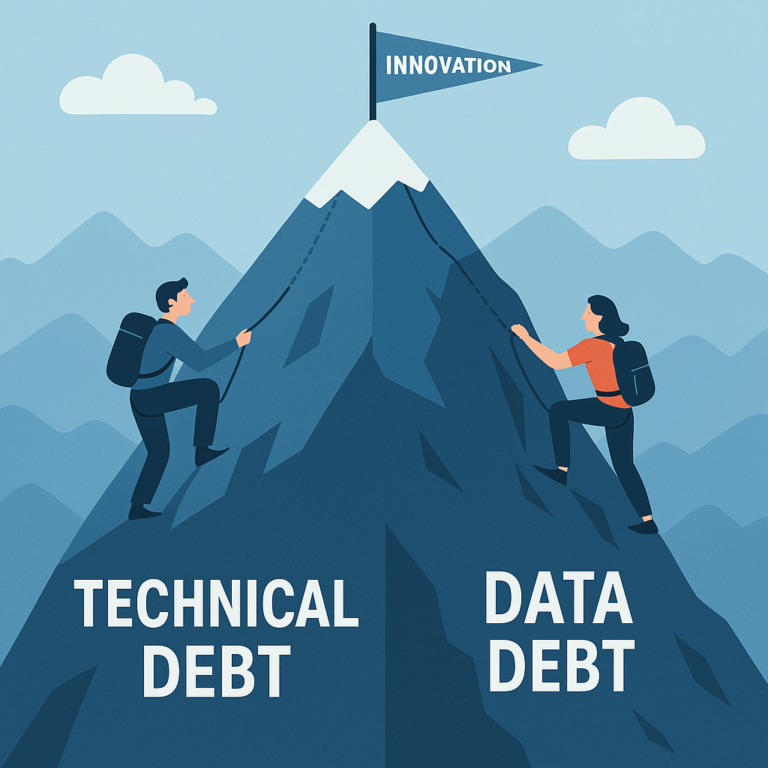Lessons from real-world partitioning wins, roadmap strategies, and why KPIs are your strongest argument.

Technical debt isn’t just a backend issue—it’s a business blocker. Learn how to frame it with KPIs, fix it with intention, and build AI-ready data systems from the ground up.
Don’t Overlook Technical Debt—Use KPIs to Justify It
One of the most overlooked aspects of roadmap planning is technical debt. The challenge? It doesn’t always have an immediate, visible business outcome. The product might still function, so it’s tempting to prioritize new features instead.

But the hidden cost of technical debt often shows up in:
• Complex workarounds
• Inefficient processes
• Slower decision-making
• Increased operational costs
A Real-World Example: Optimizing Data Partitioning for Performance Gains
The Challenge
We had terabytes of data partitioned by process date/time—when data was ingested.
But analysts, dashboards, and ML models needed data by business date/time—when the actual event occurred.
This mismatch caused:
• Complex, inefficient queries
• Slow dashboard loading
• Increased compute time
• Frustrated analysts and delayed decisions

The Experiment
We ran a proof of concept (POC) comparing partitioning strategies. The results?
• 60% faster data access speed
• Faster report generation
• Happier analysts with fewer workarounds
• More efficient ML models powered by accurate event timestamps
The Lesson
This wasn’t about fixing a broken system—it was about removing friction. And without KPIs like query time reduction or analyst productivity gains, this optimization wouldn’t have made the roadmap.
Key Takeaway:
Technical debt isn’t just bugs or old code—it’s the opportunity cost of doing nothing.
Use KPIs to translate technical debt into measurable business value. That’s how you move it up on the priority list.
How This Changed My Roadmapping Approach
Now, I always ask:
• What measurable impact will this change have?
• Can we tie it to business outcomes like time-to-insight or cost savings?
• Will it reduce friction for analysts, developers, or decision-makers?
Framing technical work around value and velocity has helped me build more scalable, sustainable roadmaps—with stronger stakeholder support.
One More Layer: The Hidden Technical Debt in Data Itself
Technical debt doesn’t stop at pipelines or code. There’s another form: data debt

When organizations ingest massive volumes of data without structure, tagging, or governance, they accumulate a different kind of debt—the kind that clouds insight and stalls innovation.
Taming Unstructured Data
For structured data, insights are easier. But for semi-structured and unstructured formats like JSON or XML, you need:
• Automated parsers
• Metadata tagging
• Schema evolution support
• Ingestion systems built for flexibility
Understanding your data = unlocking long-term value. When product and engineering teams align around this, companies leap years ahead of competitors.
Don’t Ignore This: Data Quality Is the Foundation for Everything AI
In an AI-driven world, data quality is foundational. No matter how advanced your models, if the data is flawed, the insights will be too.
Why Data Quality Matters
• Garbage in, garbage out
• Misleading dashboards = bad business calls
• Loss of trust in analytics
A Real Strategy: Build Data Quality Into the Roadmap
• Automated quality frameworks – Catch schema drift, nulls, broken pipelines
• Standardized ETLs – Embed validation at every stage
• Proactive anomaly detection – Fix problems before they snowball
The goal? Deliver clean, trustworthy data—fast. So data scientists and analysts can focus on value, not cleanup.
What About You?
Technical debt, data quality, and roadmap prioritization are challenges every data or product team faces—but how we approach them makes all the difference.
Have you dealt with technical debt in your projects?
Used KPIs to drive prioritization?
Implemented a quality framework that changed everything?
I’d love to hear your experience.
Drop a comment, share a story, or connect with me—I’m always learning from how others are solving these real-world challenges.
Let’s start a conversation.

